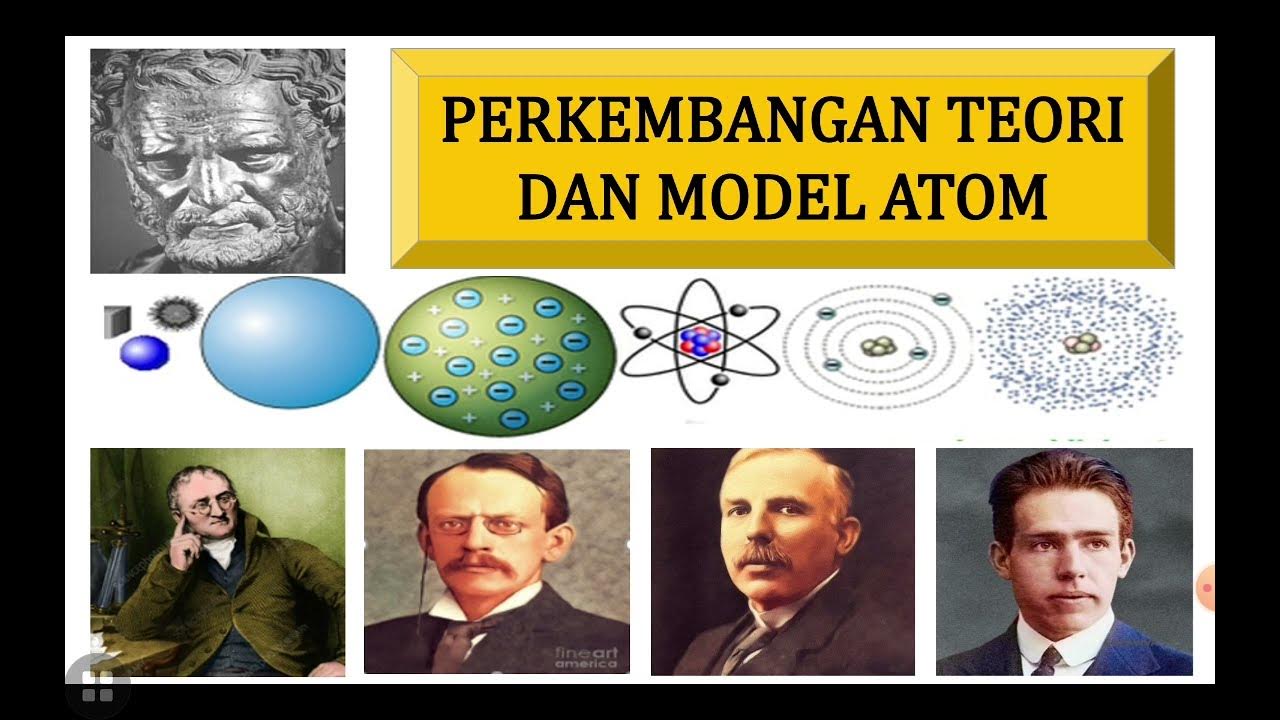PERKEMBANGAN MODEL ATOM ( DALTON, THOMSON, RUTHERFORD, NIELS BOHR, MEKANIKA KUANTUM)
Summary
TLDRThis video covers the evolution of atomic theory, starting with Dalton's concept of indivisible atoms. It explores Thomson's discovery of the electron, Rutherford's identification of the atomic nucleus, and Bohr's explanation of electron orbits and energy levels. Finally, the quantum mechanics model is discussed, emphasizing electron wave-particle duality and the uncertainty of electron positions. The video highlights key experiments, discoveries, and the growing complexity of atomic theory, illustrating how scientific advancements have shaped our understanding of atoms and chemistry.
Takeaways
- 😀 Dalton's atomic theory proposed that atoms are indivisible and cannot be seen, but later theories revealed atoms contain smaller particles.
- 😀 Thomson's cathode ray experiment led to the discovery of the electron, suggesting atoms are not empty space but contain negatively charged particles.
- 😀 Rutherford's gold foil experiment showed that atoms have a small, dense, positively charged nucleus, and most of the atom's volume is empty space.
- 😀 Rutherford's atomic model describes a nucleus surrounded by electrons, but it couldn't explain why electrons don’t spiral into the nucleus.
- 😀 Electrons, protons, and neutrons are the key particles in an atom, with protons being positively charged, electrons negatively charged, and neutrons having no charge.
- 😀 Bohr improved Rutherford's model by introducing electron energy levels (shells), where electrons remain in fixed orbits unless they absorb or emit energy.
- 😀 Bohr's model explains the colors of emitted light (like in lithium and sodium) when electrons jump between energy levels, absorbing or emitting photons.
- 😀 Bohr's model worked for single-electron atoms like hydrogen but couldn't explain the behavior of atoms with multiple electrons.
- 😀 Quantum mechanics introduced the concept of electron wave-particle duality, showing that we can't precisely determine an electron's position, only its probability.
- 😀 The quantum mechanical model explains electron behavior using orbitals, with electrons existing in regions of probability around the nucleus, not in fixed paths.
Q & A
What was Democritus' contribution to the atomic theory?
-Democritus proposed that atoms are the smallest indivisible particles that cannot be seen or divided further.
What is the key point of Dalton's atomic theory?
-Dalton's atomic theory states that atoms are indivisible particles and that atoms of different elements combine in simple whole-number ratios to form compounds.
What was Thomson's atomic model based on?
-Thomson's atomic model, known as the 'plum pudding model,' was based on his cathode ray experiment, which discovered the electron.
What significant discovery did Rutherford make through his gold foil experiment?
-Rutherford's gold foil experiment led to the discovery of the atomic nucleus, showing that atoms have a small, dense, positively charged nucleus surrounded by electrons.
What are the weaknesses of Rutherford's atomic model?
-Rutherford's model could not explain why electrons do not spiral into the nucleus due to electromagnetic radiation, which would cause them to lose energy and collapse into the nucleus.
What was Bohr's major improvement to Rutherford's atomic model?
-Bohr's model introduced the concept of electrons moving in fixed orbits or shells around the nucleus, where each orbit has a specific energy level.
How did Bohr's model explain the emission of energy by electrons?
-Bohr's model explained that when electrons absorb energy, they jump to higher orbits, and when they fall back to lower orbits, they emit energy in the form of light, such as the flame colors seen in elements like lithium and sodium.
Why did Niels Bohr's model only apply to hydrogen atoms?
-Bohr's model was only applicable to hydrogen because it could explain the behavior of a single electron. For atoms with more electrons, the model could not account for the complexities of electron interactions.
What is the quantum mechanics atomic model, and how is it different from previous models?
-The quantum mechanics atomic model, developed by scientists like de Broglie, incorporates the dual nature of electrons as both particles and waves. It suggests that the position of electrons in an atom cannot be determined with certainty but rather as a probability around the nucleus.
How does the quantum mechanical model explain the behavior of electrons?
-The quantum mechanical model uses the concept of orbitals, regions where electrons are most likely to be found, rather than fixed orbits. It incorporates wave equations to predict the energy and position of electrons with a degree of probability, not certainty.
Outlines

Cette section est réservée aux utilisateurs payants. Améliorez votre compte pour accéder à cette section.
Améliorer maintenantMindmap

Cette section est réservée aux utilisateurs payants. Améliorez votre compte pour accéder à cette section.
Améliorer maintenantKeywords

Cette section est réservée aux utilisateurs payants. Améliorez votre compte pour accéder à cette section.
Améliorer maintenantHighlights

Cette section est réservée aux utilisateurs payants. Améliorez votre compte pour accéder à cette section.
Améliorer maintenantTranscripts

Cette section est réservée aux utilisateurs payants. Améliorez votre compte pour accéder à cette section.
Améliorer maintenantVoir Plus de Vidéos Connexes

Kimia X - Struktur Atom #3 | Perkembangan Teori dan Model Atom

Modelos de Dalton e Thomson [Módulo 02 - Aula 01]

Struktur Atom • Part 1: Perkembangan Model Atom

Evolution of Atomic Model 400 BC - 2020 | History of the atom Timeline, Atomic Theories

Struktur Atom - Perkembangan Model Atom Dalton, Thomson, Rutherford, Bohr, Mekanika Kuantum -Kimia X

Atomic Structure | Grade 8 Science DepEd MELC Quarter 3 Module 3
5.0 / 5 (0 votes)
